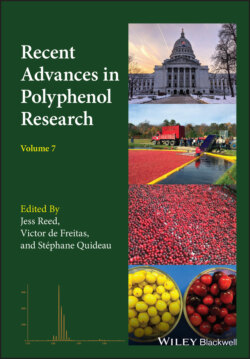Читать книгу Recent Advances in Polyphenol Research - Группа авторов - Страница 25
References
Оглавление1 Basílio, N., Cruz, L., Freitas, V., et al. (2016). A multistate molecular switch based on the 6,8 rearrangement in bromo‐apigeninidin operated with pH and host–guest inputs. Journal of Physical Chemistry, 120 (29): 7053–7061.
2 Basílio, N., Lima, J.C., Cruz, L., et al. (2017). Unveiling the 6,8 rearrangement in 8‐phenyl‐5,7‐dihydroxyflavylium and 8‐methyl‐5,7‐dihydroxyflavylium through host‐guest complexation. European Journal of Organic Chemistry, 37: 5617–5626.
3 Basílio, N., and Pina, F. (2014). Flavylium network of chemical reactions in confined media: modulation of 3’,4’,7‐trihydroxyflavilium reactions by host–guest interactions with cucurbit[7]uril. ChemPhysChem, 15 (11): 2295–2302.
4 Bjorøy, Ø., Rayyan, S., Fossen, T., et al. (2009). Structural properties of anthocyanins: rearrangement of c‐glycosyl‐3 deoxyanthocyanidins in acidic aqueous solutions. Journal of Agricultural and Food Chemistry, 57 (15): 6668–6677.
5 Brouillard, R., and Dubois, J.E. (1977). Mechanism of structural transformations of anthocyanins in acidic media. Journal of the American Chemical Society, 99 (5): 1359–1364.
6 Brouillard, R., Iacobucci, G.A., and Sweeny, J.G. (1982). Chemistry of anthocyanin pigments. 9. UV‐visible spectrophotometric determination of the acidity constants of apigeninidin and three related 3‐deoxyflavylium salts. Journal of the American Chemical Society, 104 (26): 7585–7590.
7 Cruz, L., Basílio, N., Freitas, V., et al. (2016). Extending the study of the 6,8 rearrangment in flavylium compounds to higher pH values. Inter‐conversion between 6‐bromo and 8‐bromo‐apigeninidinin. Chemistry Open, 5 (3): 236–246.
8 Sousa, J.L., Gomes, V., Mateus, N., et al. (2017). Synthesis and equilibrium multistate of new pyrano‐3‐deoxyanthocyanin‐type pigments in aqueous solutions. Tetrahedron, 73 (41): 6021–6030.
9 Cruz, L., Sousa, J.L.C., Gomes, V., et al. (2017). Chemical equilibrium characterization of pyrano‐3‐deoxyanthocyanin derivatives. Tetrahedron 73: 6012–6030.
10 Dangles, O., Saito, N., and Brouillard, R. (1993). Kinetic and thermodynamic control of flavylium hydration in the pelargonidin‐cinnamic acid complexation. Origin of the extraordinary flower color diversity of Pharbitis nil. Journal of the American Chemical Society, 115 (8): 3125–3132.
11 Fernandes, A., Brás, N., Mateus, N., et al. (2015). A study of anthocyanin self‐association by NMR spectroscopy. New Journal of Chemistry, 39: 2602–2611.
12 Goto, T., and Kondo, T. (1991). Structure and molecular stacking of anthocyanins – Flower color variation. Angewandte Chemie International Edition, 30 (1): 17–33.
13 Jurd, L., (1963). Anthocyanins and related compounds. I. Structural transformations of flavylium salts in acidic solutions. The Journal of Organic Chemistry, 28 (4): 987–991.
14 Hondo, T., Yoshida, K., Nakagawa, A., et al. (1992). Structural basis of blue‐colour development in flower petals from Commelina communis. Nature, 358 (6386): 515–518.
15 Lehn, J.M. (1995). From molecular to supramolecular chemistry. In: Supramolecular Photochemistry: Concepts and Perspectives. Weinheim: Wiley‐VCH.
16 Mendoza, J., Basílio, N., Pina,F., et al. (2018). Rationalizing the color in heavenly blue anthocyanin. A complete kinetic and thermodynamic study. Journal of Physical Chemistry .B, 122 (19): 4982–4992.
17 Mendoza, J., Basílio, N., de Freitas, V., et al. (2019). New procedure to calculate all equilibrium constants in flavylium compounds: application to the copigmentation of anthocyanins. ACS omega, 4 (7): 12058–12070.
18 Petrov, V., Diniz, A.M., Cunha‐Silva, L., et al. (2013). Kinetic and thermodynamic study of 2’‐hydroxy–8‐methoxyflavylium. Reaction network interconverting flavylium cation and flavanone. RSC Advances, 3 (27): 10786–10794.
19 Petrov, V., Gomes, R., Parola, A.J., et al. (2008). 2’‐hydroxyflavylium: introducing flavanones into the flavylium network of chemical reactions. Tetrahedron, 64 (4): 714–720.
20 Petrov, V., Parola, A.J., and Pina, F. (2012). Isomerization between 2‐(2,4‐Dihydroxystyryl)–1‐benzopyrylium and 7‐Hydroxy‐2‐(4‐hydroxystyryl)‐1‐benzopyrylium. Journal of Physical Chemistry, 116 (31): 8107–8118.
21 Petrov, V., Stanimirov, S., Petrov, I.K., et al. (2013). Emptying the β‐cyclodextrin cavity by light. Photochemical removal of the trans‐chalcone of 4’,7‐dihydroxyflavylium. Journal of Physical Chemistry, 117 (41): 10692–10701.
22 Pina, F. (2014a). Thermodynamic and kinetic processes of anthocyanins and related compounds and their bio‐inspired applications. In: Recent Advances in Polyphenols Research. Vol. 4, Chapter 11, (eds. Romani, A., Lattanzio, V., and Quideau, S.), 341–370. West Sussex: Wiley Blackwell.
23 Pina, F. (2014b). Anthocyanins and related compounds. Detecting the change of regime between rate control by hydration or tautomerization. Dyes and Pigments, 102: 308–314.
24 Pina, F., Melo, M.J., Maestri, M., et al. (1997). Photochromism of 4'‐methoxyflavylium perchlorate. A “write‐lock‐read‐unlock‐erase” molecular switching device. Journal of the American Chemical Society, 119 (24): 5556−5561.
25 Slavcheva, S., Mendoza, J., Stanimirov, S., et al. (2018). On the multistate of 2’‐hydroxyflavylium‐flavanone system. illustrating the concept of a timer with reset at the molecular level. Dyes and Pigments, 158: 465–473.
26 Sousa, A., Cabrita, L., Araújo, P., et al. (2014). Color stability and spectroscopic properties of deoxyvitisins in aqueous solution. New Journal of Chemistry, 38 (2): 539–544.
27 Yoshida, K., Kondo, T., Okazaki, Y., et al. (1995). Cause of blue petal colour. Nature, 373 (6512): 291.
28 Yoshida, K., Mori, M., and Kondo, T. (2009). Blue flower color development by anthocyanins: from chemical structure to cell physiology. Natural Product Reports, 26 (7): 884–915.
